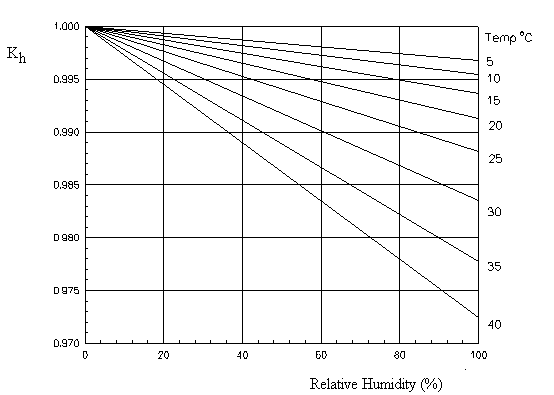
|
PROPERTIES OF THE ATMOSPHERE |
||
|
|
||
|
|
||
|
1. International Standard Atmosphere |
||
|
1.1 Sea Level Conditions |
||
|
Pressure |
101.3 kPa |
2116.7 lbf/ft2 |
|
Density |
1.225 Kg/m3 |
0.002378 slug/ft3 |
|
Temperature |
15oC or 288.2 K |
59oF or 518 R |
|
Speed of Sound |
340.3 m/s |
1116.4 ft/s |
|
Viscosity |
1.789 x 10-5 Kg/m/s |
3.737 x 10-7 slug/ft/s |
|
Kinematic Viscosity |
1.460x10-5 m2/s |
1.5723x10-4 ft2/s |
|
Thermal Conductivity |
0.02596 W/m/K |
0.015 BTU/hr/ft/oR |
|
Gas Constant |
287.1 J/Kg/K |
1715.7 ft lbf/slug/oR |
|
Specific Heat Cp |
1005 J/Kg/K |
6005 ft lbf/slug/oR |
|
Specific Heat Cv |
717.98 J/Kg/K |
4289 ft lbf/slug/oR |
|
Ratio of Specific Heats |
1.40 |
|
|
Gravitational Acceleration |
9.80665 m/s2 |
32.174 ft/s2 |
|
2. Correction for Air Density due to Humidity |
|
The density of the air for a given level of humidity can be found by applying a correction factor to the above calculated perfect gas density. |
|
|
|
The correction factor, Kh, can be found by using wet and dry bulb temperature measurements to predict relative humidity as shown in the following table. |
|
Relative Humidity (%) |
|
|
Dry Bulb oC |
Temperature Difference,oC TDRY - TWET 1 2 3 4 5 6 7 8 9 10 11 12 |
0 |
81 64 46 29 13 - - - - - - - |
2 |
84 68 52 37 22 7 - - - - - - |
4 |
85 71 57 43 29 16 - - - - - - |
6 |
86 73 60 48 35 24 11 - - - - - |
8 |
87 75 63 51 40 29 19 8 - - - - |
10 |
88 77 66 55 44 34 24 15 6 - - - |
12 |
89 78 68 58 48 39 29 21 12 - - - |
14 |
90 79 70 60 51 42 34 26 18 10 - - |
16 |
90 81 71 63 54 46 38 30 23 15 8 - |
18 |
91 82 73 65 57 49 41 34 27 20 14 7 |
20 |
91 83 74 66 59 51 44 37 31 24 18 12 |
22 |
92 83 76 68 61 54 47 40 34 28 22 17 |
24 |
92 84 77 69 62 56 49 43 37 31 26 20 |
26 |
92 85 78 71 64 58 51 46 40 34 29 24 |
28 |
93 85 78 72 65 59 53 48 42 37 32 27 |
30 |
93 86 79 73 67 61 55 50 44 39 35 30 |
32 |
93 86 80 74 68 62 57 51 46 41 37 32 |
34 |
93 87 81 75 69 63 58 53 48 43 39 35 |
36 |
94 87 81 75 70 64 59 54 50 45 41 37 |
|
The relative humidity can be used to obtain the density correction factor from the following graph. |
Density Correction due to Humidity

|
Note : Density correction factor assumes approximately sea level pressure in the application of these formulae. |
|
Reference: "Handbook of Chemistry and Physics" Ed R.C.Weast, The Chemical Rubber Co., Ohio, 1964 |
© AMME, University of Sydney, 1998-2006